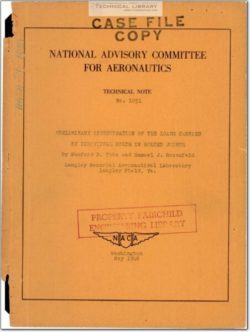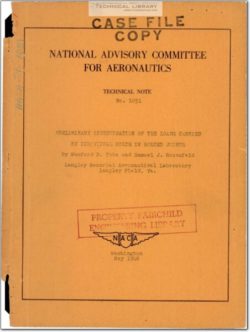NACA-TN-1051

- Version
- 1941 Downloads
- 34.41 MB File Size
- 1 File Count
- April 19, 2016 Create Date
- April 19, 2016 Last Updated
National Advisory Committee for Aeronautics, Technical Notes - Preliminary Investigation of the Loads Carried by Individual Bolts in Bolted Joints

A general solution is presented for the determina-
tion of loads carried by individual bolts in symmetrical
butt joints. Expressions for bolt behavior are given by
which the general solution may be readily adapted to the
numerical calculation of bolt loading in joints made of
any of several combinations of materials common to air-
plane construction, and an example is solved to illustrate
the numerical procedure. All expressions are confined to
the range of elastic action of joint components.
From the tests of three—bolt joints, agreement within
about 10 percent was found between theoretical and experi—
mental bolt loads within the elastic range. Although the
bolts carried markedly unequal loads in the elastic range
(as indicated by theory), it was found for such joints
(containing not more than three bolts in the line of
stress) that a process of bolt-load equalization took
place beyond the limit of elastic action which for practi—
cal nurooses caused the bolts to be loaded equally at
joint failure. Information is needed with respect to
multirow joints, however, because in the elastic range
the bolts in the first rows carry far greater loads
than interior bolts and joint failure may occur before
complete equalization of bolt loads is realized.
In recent years the need for more rational means of
design and analysis of connections has been emphasized by
the exacting requirements of modern airplane construction.
The methods of joint analysis are far more antiquated than
those employed for other parts of the aircraft structure.
Improved methods for predicting joint strength offer a
means of reducing weight if they are adapted to make more
efficient use of all connectors within a joint. From the
production viewpoint, Jenkins (reference 1) has shown that
approximately 50 percent of the total cost of the all—
metal airplane frame is due to connecting the various
components of the structure and that the cost of riveting
and bolting constitutes between 80 and 90 percent of the
total cost of connections. These conditions suggest a
promising field for investigation.
| File | Action |
|---|---|
| NACA-TN-1051 Preliminary Investigation of the Loads Carried by Individual Bolts in Bolted Joints.pdf | Download |

Comment On This Post